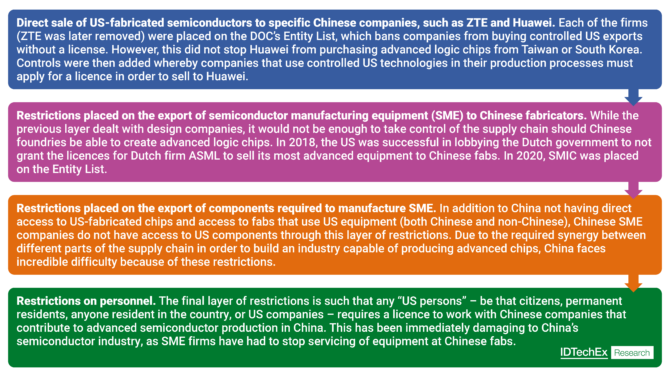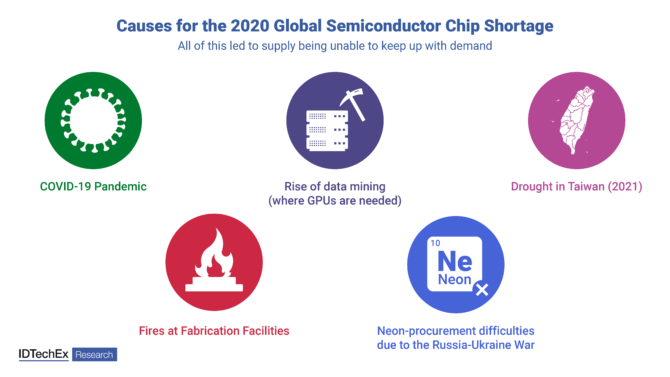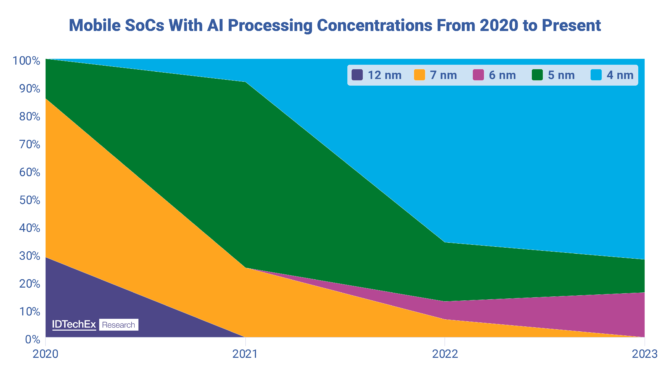
Chips as currency? America, China and the AI race
By Leo Charlton, Technology Analyst at IDTechEx, Cambridge, UK
Electronics Semiconductors Supply Chain AI artificial China chips distribution intelligence semiconductors supply Chain trade war USAIDTechEx discusses the potential consequences of this trade war
Running in the background to the more visible, very real wars occurring around the world at present, there is another, economic and industrial in nature. This is a trade war between two principals: the USA and China. The potential consequences of this trade war are incredibly significant to global geopolitics, as how the interaction between the two parties is handled will determine a basis for any future cooperation between the two principals as well as their respective allies. This trade war is over the production of semiconductor chips, those small pieces of (mainly) electronic circuitry that are found in many modern-day devices, from smartphones to televisions, cars to computers. A recent report from IDTechEx highlights the part that artificial intelligence (AI) plays in this trade war, where the race for AI supremacy has become a national concern.
The shortage, where demand exceeds supply
But before discussing the role of AI, it is more instructive to start at the beginning or thereabouts. This does not require going so far back in time – only five years, in fact, to 2018. From January of that year, under the presidency of Donald Trump formerly and now President Joe Biden, the US has enforced several layers of restrictions and barriers to trade on China where semiconductors are concerned, each successive layer aiming to plug a hole that the previous layer(s) had left. These restrictions are shown below.
The reasons for these restrictions are multiple, starting with simple economics (where the US wishes to halt China’s growing market share in the semiconductor supply chain) before moving onto interwoven concerns such as risk exposure and the use of semiconductors for militaristic purposes.

The tiered restrictions placed on China by the US, where semiconductor design, manufacture, and imports are concerned. Source: IDTechEx
With regards to geographic risk exposure, since 2020, there has been a global chip shortage, where demand for semiconductor chips has exceeded supply. This shortage exposed US design companies to the risk of relying upon South-East Asia manufacturing capabilities, as lead times elongated to upwards of 3 months by the beginning of the crisis.
A number of complementing factors caused the global chip shortage. Principle among them is the COVID-19 Pandemic, which saw a rise in demand (due to more people working from home and so in need of personal computers) and a fall in supply (due to lockdowns across Asia resulting in plants being shut down). Other factors include the rise of data mining (where GPUs are needed, thus once again increasing demand); a drought that hit Taiwan in 2021, resulting in problems with producing ultra-pure water to clean factories and wafers; fires at several fabrication facilities owned by Asahi Kaseri, Renesas and ASML; and difficulties procuring neon (used for lasers in chip manufacture) due to the Russia-Ukraine War, as Ukraine was responsible for providing more than 90% of the US semiconductor-grade neon.
These events combined would likely be enough for a country such as the US to consider investing in their own production capabilities (where the US Chips and Science Act of 2022 is discussed in more detail in the aforementioned IDTechEx report). But the level of spending on semiconductor imports by China, as well as the blurred line between commercial and military ventures in the country, has led the US to become wary of outfitting a rival economy with the tools to surpass them in key technology areas. This is where AI comes into play.
AI as a motivator
In addition to the restrictions presented above, on August 26th, 2022, the US government placed a ban on AMD and Nvidia from exporting chips that can be used to support AI workloads to China. According to an August SEC Filing made by Nvidia, this comes in the form of a license agreement, effective immediately, for any future export to China (including Hong Kong) and Russia of Nvidia’s A100 and forthcoming H100 integrated circuits. Any systems that incorporate the A100 and H100 ICs are also covered by the new license requirement, as well as any future integrated circuits that are roughly as advanced as the A100. The filing asserts that the US government has indicated that the new license requirement will address the risk that the covered products may be used in a military capacity by China or Russia. In a similar fashion, a spokesperson for AMD – speaking with Reuters – said that the company had received new license requirements that effectively put a stop on exports of AMD’s MI250 AI chips to China.

The global semiconductor chip shortage. Source: IDTechEx
This information alludes to the fact that the restrictions imposed upon Chinese companies by the US government are not simply a matter of trying to take some control of the supply chain from the APAC region but also a matter of national security. The measures are an attempt by the US to arrest China’s AI surge by preventing the type of advanced technologies that are needed for China to realize AI supremacy (a not unfounded concern, as by 2018, China had filed 2.5X more patents in AI technologies than the US). Such is the interwoven aspect of commercial and military endeavors in China that the Biden administration has effectively stopped trying to block military-affiliated exports while retaining commercial exports and the revenue that generates. As such, to quote the Center for Strategic & International Studies, “High-end AI chips can no longer be sold to any entity operating in China, whether that is the Chinese military, a Chinese tech company, or even a US company operating a data center in China”.
AI not only promises to be one of the biggest drivers of economic advances within the next quarter century, but for China, AI mastery represents the ability to perfect a model of governance in keeping with existing architectures. The effectiveness of AI models comes largely down to the quality and breadth of the training data set provided. Given that China can collect significant volumes of citizen data, the country is poised to reap the benefits of widespread AI usage.
China’s response
China has – until recently – been rather quiet in the face of these restrictions, although some displeasure was expressed when TSMC (a Taiwanese semiconductor fabricator that accounts for the vast majority of leading-edge node manufacture globally) announced plans to build new fabrication facilities in Arizona, USA, last year. But in July 2023, China struck back, with restrictions placed on the export of Gallium and Germanium, materials that are used in certain semiconductor chip manufacture.
Germanium is used in applications such as thermal imaging cameras, solar panels, and telecommunications, where germanium can be used in photodiodes to convert light signals to electrical ones. Gallium is often paired with arsenic to form gallium arsenide, a compound semiconductor that can operate at higher temperatures and frequencies than silicon. At present, China produces around 98% of the world’s gallium and controls around 68% of global refined germanium production in various countries, according to the US Geological Survey. The impact that restrictions on these material exports have on the US and allied countries is not to be downplayed.
Outlook
Both European and Asian delegates alike have warned against these ongoing restrictions by both principals, given that the onus on the shoring up of national interests currently involves punishing the other party concurrently. And the harder that the US pushes against China, the harder that China will lean into plugging money into their own domestic supply chain (and given that in 2021 China spent the equivalent of USD$432 billion on imported microprocessors, money that they may no longer be able to be spend on imports, China is certainly not short of funding).
As with most countries, China has not looked to develop an isolated, front-to-back domestic semiconductor supply chain to date, as they have had the option to work with superior foreign partners rather than domestic firms that do not meet the same standards; design companies could work with established fabs in Taiwan rather than inferior domestic fabs, and Chinese fabs could buy foreign semiconductor manufacturing equipment (SME) with proven quality. Now that they are cut off from these possibilities, China must look to growing domestic capabilities.
In the short term, this will prove to be very difficult for China. While the country has been stockpiling chips and SMEs in anticipation of these imposed controls (the 7nm chip produced by SMIC was produced using existing deep ultraviolet (DUV) machines), these resources will eventually run out, and so China must look to develop domestic capabilities if their semiconductor industry isn’t to completely dry out, at least in terms of the more advanced node processes. It seems likely that, for the next few years, China will have to rely on more mature node processes in the creation of new chips.

From a survey of 91 smartphones released from 2020 with AI coprocessing capabilities, the trend is for successively-released models to move to leading-edge nodes. Given that MediaTek, Qualcomm, and Apple are the industry leaders in the smartphone SoC space, it is unlikely that Chinese companies will be able to compete appreciably in this space any time soon. However, where leading-edge nodes are not as necessary to functioning edge devices – such as in matters of security and industrial settings – China may indeed be able to find more traction through the short-term focus on mature node technologies. Source: IDTechEx
This being said, it is unlikely that China will have no foreign support at all, at least in terms of SME and components supply. Companies that have a large stake in the Chinese market – such as Zeiss, a German company that supplies mirrors to ASML for their extreme ultraviolet (EUV) lithographic machines, and where China is their fastest growing market – may be unwilling to relinquish revenues generated from China. In an effort to abide by the US export controls, companies may engineer out the US inputs or components in their products such that they can sell these without repercussions in China.
In the longer term, there is cause for cautious optimism for China. Forced to work together in a way that they have not done previously, China’s fabs, design companies, and SME firms may form an ecosystem that is not only stronger from the forced collaboration but also more thoroughly isolated from global supply chain disruptions than most other countries (and, in addition, free from US controls). This comes with significant hurdles, but these may be removed or – at the least – lessened should other countries feel the adverse economic effects of being unable to bolster their raw material supply.
The story is far from being finished, but with a projected growth of US$257.6 billion by 2033 for AI chips alone, there is much to be gained and lost over the next ten years.
Report coverage
IDTechEx forecasts that the global AI chips market will grow to US$257.6 billion by 2033. The report covers the global AI Chips market across eight industry verticals, with 10-year granular forecasts in seven different categories (such as by geography, by chip architecture, and by application). In addition to the revenue forecasts for AI chips, costs at each stage of the supply chain (design, manufacture, assembly, test & packaging, and operation) are quantified for a leading-edge AI chip. Rigorous calculations and a customizable template for customer use are provided, and analyses of comparative costs between leading and trailing edge node chips.
——————————
IDTechEx’s latest report, “AI Chips 2023-2033”, provides insights into the markets, players, technologies, opportunities, and challenges. Click here to view.
